Tilapia cage farming
The aquaculture sector has increasingly played a vital role in meeting the growing global demand for food. This role has internationally widely recognised in recent years. Freshwater aquaculture has been commonly practiced in the Mekong Delta region for centuries, providing livelihoods to poor rural people as well as food supplies, employment and income.
Cultivation of fish in cages is a dominant type of freshwater aquaculture in the southern provinces of Viet Nam and the Mekong Delta. Due to limited land availability, cage culture of fish in Tien Giang has expanded by effectively taking full advantage of the available water resources.
Tilapia cage farms are the most popular freshwater cultivation practice in Tien Giang which has contributed substantially to livelihoods, food demand and poverty alleviation. However, this type of floating fish cultivation is increasingly facing difficult challenges, including a deterioration in water quality and fish mortalities. Safe environments and clean water are required to underpin the sustainability of tilapia cage farming in Tien Giang.
Study location and methodology
Tien Giang is about 70 km from Ho Chi Minh City and has a total area of about 2,482 km2. It is situated in the northeastern Mekong Delta and stretches about 120 km along the north bank of the Tien River (one of the tributary ends of the Mekong River) and has a 32 km border with the East Sea.
Tien Giang is the fifth largest producing province in the Mekong Delta, and the fourth in terms of total culture area. The total area under fish cultivation (mainly catfish) was 400 ha and fish production was 27,000 tonnes in 2005.
Thoi Son Islet is located in the Tien River, close to My Tho City, and is one of the major tilapia (Oreochromis niloticus) cage farming areas of Tien Giang. The location of Tien Giang and Thoi Son Islet are shown in the satellite view on the adjacent page.
On-site sampling, laboratory analysis and questionnaire surveys were deployed to collect data from the local cage farmers. Surveys and sampling were conducted over three seasons in 2009 (dry, rainy and transitional seasons). Information collected using semi-structured checklists in questionnaire sets included:
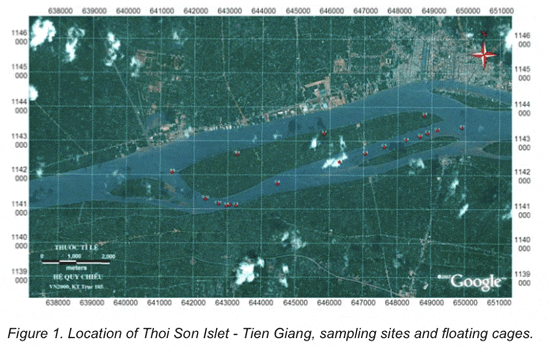
- Data on socio-economic aspects such as age, education level, investment costs and stakeholders’ concerns regarding the long-term environmental sustainability of intensive farming systems; and
- Data relating to farming activities such as seed supply, water use, stocking density, feeds, feed management, disease issues and health management.
SPSS 13.0 for WINDOWS and Excel software were used to analyse frequencies, case summaries, and to conduct T-test, one-way ANOVA and linear regression in order to understand the socio-economic situation, environmental issues and improve production of farming in fish cages.
Tilapia cultivation practices and emerging issues
The practice of farming fish in floating cages has been underway in Tien Giang for ten years and is the predominant fishery activity along the Tien River. Not surprisingly, the Tien Giang aquaculture sector has annually provided around 18,000 tonnes of fish meat and substantially created job for more than 3,000 people and 10,000 workers relating to services and household levels.
About 145,000 m3 of total area of water surface is being used for fish cage farms. There were approximately 1,573 floating cages throughout four major districts, comprising: Chau Thanh, My Tho, Cai Lay and Cai Be. In the first five months of 2009 alone, 128 new floating cages were constructed and 1,046 tonnes of fish were harvested (Table 1).
Presently, farmers culture tilapia year around and are using more pellet feed and chemicals than previously due to higher stocking densities, water quality deterioration and consequently disease during off-seasons, especially during the floods.
Most cages are topped with wooden frames which are also home for the farmers. Cage components consist of a frame, mesh or netting, feeding ring, lid and flotation. Cage shapes may be square or rectangular. The most common cage size is: 4 x 8 x 3 m (length x width x depth). Cages may be categorised as small (less than 100 m3) and medium (from 100 to 500 m3).
About 74 per cent of the cages are small and this influences the method of harvest and the cage farmers’ finances in Thoi Son Islet.
Water quality
Cages are floated in clusters along the banks of the Tien River and concentrated in My Tho City. However, there are a number of emerging problems with self-pollution due to ineffective cultivation practices and unplanned farm development.
First of all, wastes from the fish and uneaten feed are discharged directly into river, yet water quality monitoring has not been conducted adequately. Farmers do not have any tools for checking water quality (oxygen, pH and temperature), which are essential aquaculture practices.
Secondly, floating cages are densely and spontaneously set by farmers themselves, without planning. This is the most critical survey finding as cage systems are located nearby industrial effl uents and sometimes block the navigation of the river by local vehicles.
More importantly, My Tho City and the My Tho industrial park are not far from production sites, being only 500 m away from some cage clusters. Industrial and domestic wastewater is ultimately diffused along the river’s banks and through the cage culture system.
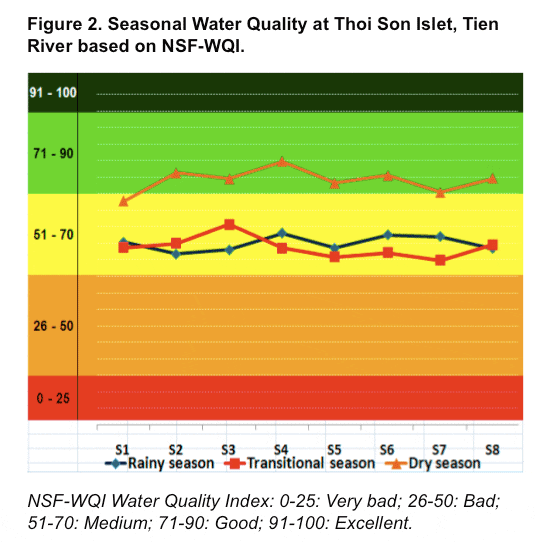
Although farmers are aware of environmental pollution and take it seriously (78 per cent), they cannot point out the main reason of the deteriorating water quality systematically (42 per cent). The majority of interviewees argued that the industrial development may cause water pollution (58 per cent). Unfortunately, there is no regulation or document on environmental issues relating to cage aquaculture at the local level.
Water quality in the Thoi Son Islet Tilapia cage farming was assessed over three seasons: dry, rainy and transitional seasons. During the dry season, the water quality of Tien River is better than in the wet and transitional seasons. Most importantly, water quality in the wet season has significantly impacted cage culture production, causing pH, dissolved oxygen, chemical oxygen demand, nitrite, nitrate and phosphate to fall within undesirable levels. The seasonal water quality in the Tien River (Thoi Son Islet section) can be expressed based on Water Quality Index (WQI) and is depicted in Figure 2.
Seed supply
Seed quality is the most vital concern of farmers, especially for the systems with higher level of intensification. In Thoi Son Islet, fingerlings are purchased from private hatchery providers (Cai Lay, Cai Be and Phu Tuc districts) without the inspection of local Department of Fisheries. There is no evidence to certify that fingerlings are good quality, fully ripe or free from restricted chemicals/drugs. Hence nursery owners do not bear the responsibility for the final products. As a result, the loss rate in the nursery stage of cultivation is very high.
The stocking density of cage farmed tilapia is a significant factor that impacts on the survival, growth and food conversion ratio (FCR). The research survey and findings showed that the average density in Thoi Son Islet cage farms is 8.48 ± 1.83 kg/m3 with average weight of seed is 20.52 ± 8.38 g/fish.
Importantly, there is a linear correlation between stocking density and loss rate and food conversion ratio as shown in Figure 3a and 3b. Practically, high density is not a good practice for caged tilapia to survive and develop. The research findings reveal that there is a relation between the stocking density and: (i) the FCR (r = 0.89, P < 0.01) ; (ii) the loss rate (r = 0.61, P < 0.01).
Feeds and feed management
There are three major components of investment costs for caged tilapia cultivation, including: (i) feed; (ii) seed or fingerlings; and (iii) veterinary including chemicals and drugs. Of these, feed is the highest cost in tilapia cage culture in Thoi Son Islet.
Two kinds of feed used for this system are: (i) manufactured feed; and (ii) home-made feed. The ingredients of home-made feed are various such as rice bran, broken rice and trash fish. Although that kind of feed helps to reduce costs, its protein level is quite low and FCR is rather high.
Feeding practices vary from farmer to farmer. Interestingly, the frequency of feeding may be three or four times a day depending on fish age and farmers’ experience. This leads to overfeeding, and in turn it causes pollution from residue, especially home-made feed. This becomes a critical problem for cage culture as the uneaten feed cannot accumulate on the bottom like in the pond culture to be removed later.
At the study area, feed ratio and FCR cannot be accurately calculated by most of the farmers, who simply feed based on their experience and observed behaviour of the fish. This results in waste and inefficient feeding practices. However, feed input was recorded by a few farmers which the owners themselves did not manage these farms (pointing to financial control rather than good farming practices).
In Thoi Son Islet, the research results show that there is a relation between the FCR and: (i) the loss rate (r = 0.65, P < 0.01); (ii) the productivity (r = -0.54, P < 0.01) as shown in Figure 3. The higher FCR the lower the productivity and higher the loss rate.
Disease issues and health management
Drugs and chemicals are used in most of the steps of the cage culture, such as: hatchery, transportation, cage preparation, stocking, nursing, fingerling and grow-out. There is no residue control on fingerlings, hence the private nurseries do not bear the responsibility for final products. This raises an issue on food quality and safety. Furthermore, most of the farms do not have drug and chemical usage-notes.
The addition of vitamins, amino-acids and probiotic-enzymes are common practices of most farmers in Thoi Son Islet. Moreover, most farmers do not know either the composition of these products nor the concept of withdrawal period. In many cases, products are not in their original packaging and sold in a hand-labelled transparent plastic bag.
Environmental assessment and management
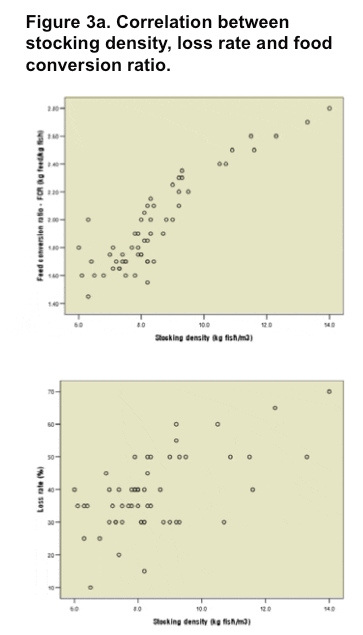
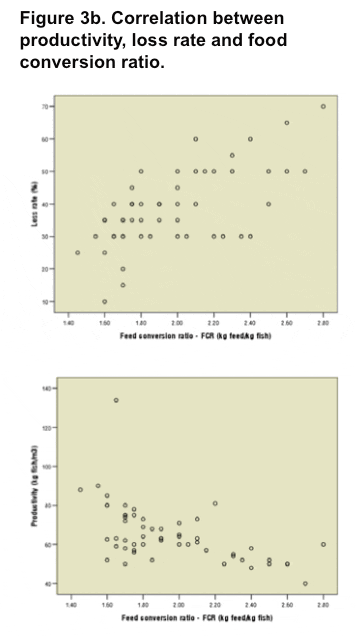
In the tilapia cage farm systems, most cages are located along river banks. The distance between cages is quite close, i.e. typically two to three meters if the cages belong to one owner or five to 10 meters if the cages belong to different owners.
On the other hand, cage locations do not follow the zoning which is encouraged by the government agencies for aquaculture. Thus, their wastes and discharges cause concerns on water quality, diseases, navigation hazards and landscape of the area. These systems also have received negative impacts from other upstream farming activities of the Tien River. Due to the open culture system, the risk of disease and parasite transfer to wild stocks would be possible.
Furthermore, the practice of farm management is poor. While management standards do not exist or have to be voluntarily implemented by farmers, training and competence of the staff are low and limited. More importantly, no records of monitoring or activities are kept.

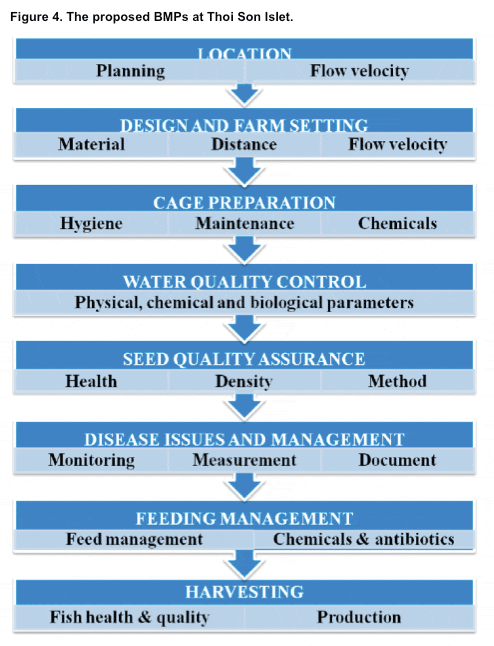
Better management practices
Given above context, a spectrum of management practices is required to improve the situation. The practices must be flexible and suitable for small-scale farms to implement. A ‘better management practice’ approach supports fish farmers to limit fish losses, reduce environmental pollution, meet standard requirements of the aquaculture sector, and manage the whole cultivation process through: location planning, cage setting, seed quality assurance, feeding method, water quality and disease control.
Better management practices can include improvements to the cage designs, checking seed quality at stocking, monitoring water quality and fish health, improving bio-security during production, keeping records and a proactive approach to health management. Figure 4 shows the proposed BMPs at Thoi Son Islet.


